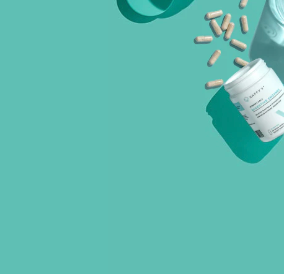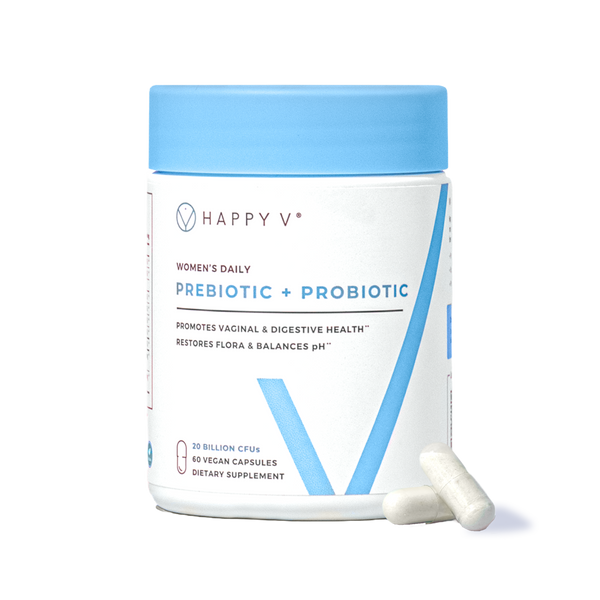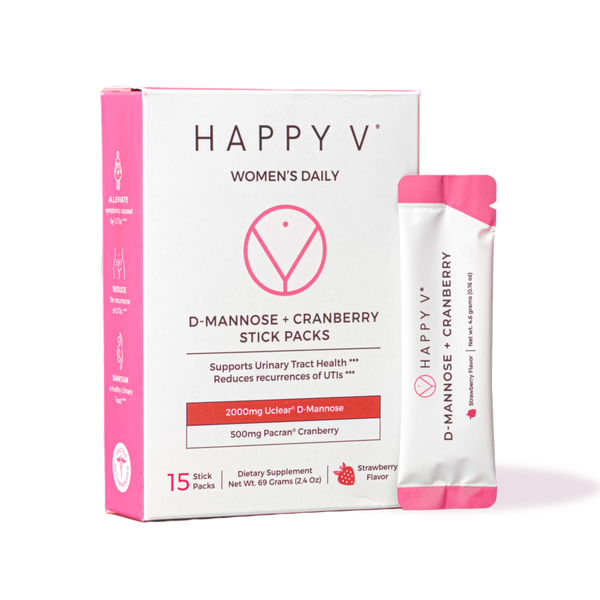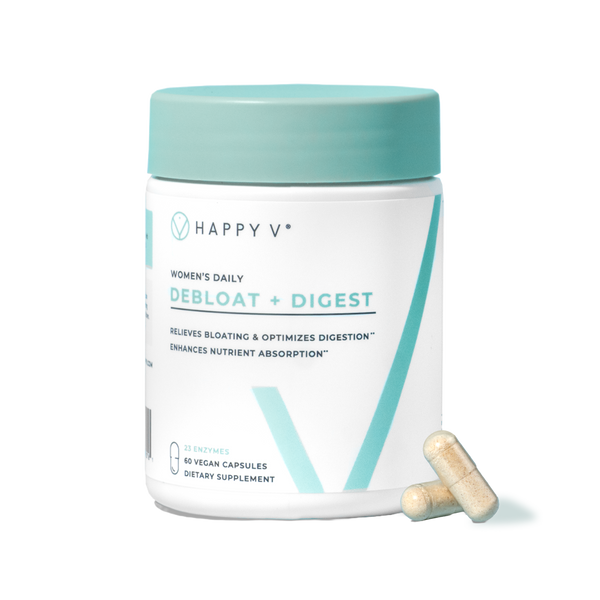- Fact Checked
- June 26, 2025
- 7 min read
Table of Contents
Let’s be real: when something’s off down there, whether it’s new vaginal discharge, irritation, or a certain fishy smell, you want answers—fast. Two of the most common causes of those symptoms? Bacterial vaginosis (BV) and trichomoniasis (trich).
They’re both vaginal infections, and their symptoms can seriously overlap. But here’s the catch: BV and trich have very different root causes, treatment options, and long-term health implications. In fact, one is an STI and the other isn’t!
Let’s break down the key differences, so you can feel more confident talking to your healthcare provider, getting the right care, and protecting your sexual health, without the stress spiral.
This post is for informational purposes only and does not constitute medical advice. See full disclaimer below.
What Is Bacterial Vaginosis?
Bacterial vaginosis (BV) is the most common vaginal infection—and by a long shot! In fact, the Centers for Disease Control and Prevention (CDC) estimates that 21 million women every year get diagnosed with BV in the United States alone.
BV isn’t technically an STI (sexually transmitted infection), but it is more likely to show up in people who are sexually active or who have frequent changes in sex partners.
What causes it?
BV is caused by an overgrowth of bacteria, especially the bacteria Gardnerella vaginalis. On its own, G. vaginalis is not problematic. In fact, even balanced microbiomes contain G. vaginalis. However, when it starts to multiply and overtake the vaginal flora, it can replace helpful Lactobacilli bacteria. This is when you will notice symptoms.
Symptoms of BV:
Believe it or not, BV isn’t always symptomatic. In fact, it’s estimated that over half of women who have an active BV infection don’t have any symptoms at all. Those women who do experience symptoms often experience:
- Thin, gray or white vaginal discharge
- A strong fishy odor, often more noticeable after sexual intercourse
- Mild vaginal itching or irritation
- Burning during urination
- Pain during sex
- No symptoms at all (but it can still cause problems if left untreated)
BV is diagnosed with a vaginal swab, pH test, and/or microscopic analysis by a healthcare provider. It’s typically treated with oral antibiotics like metronidazole or clindamycin.
What Is Trichomoniasis?
Unlike BV, Trichomoniasis (aka trich) is an STI caused by a microscopic parasite called Trichomonas vaginalis. Trich is spread exclusively through through sexual contact, including vaginal, oral sex, and anal sex.
Trich can affect anyone, regardless of gender. It’s one of the most common curable STIs, according to the CDC, but many people don’t know they have it because symptoms are often mild or totally absent.
This is why routine STI/STD testing is so important if you’re sexually active. If left untreated, even asymptomatic trich can lead to more serious health issues down the road, including pelvic inflammatory disease and complications during pregnancy.
Symptoms of trich:
- Frothy, yellow-green vaginal discharge
- Musty or unpleasant odor
- Redness, soreness, or itching around the vulva
- Burning or pain during urination
- Discomfort during sexual contact
- Increased discharge volume
- Or no symptoms at all
Trich is usually treated with a single dose or short course of metronidazole or tinidazole. Partner treatment is essential to prevent recurrence.
BV vs. Trich: Key Differences
This chart highlights the key differences between BV and trich but remember your doctor is the only person who should be making a formal diagnosis!
| Feature | Bacterial Vaginosis (BV) | Trichomoniasis (Trich) |
| Cause | Bacterial overgrowth | Parasite (Trichomonas vaginalis) |
| Type | Vaginal infection, not an STI | Sexually transmitted infection (STI) |
| Transmission | Linked to sexual activity, not directly spread | Spread via sexual intercourse, including oral and anal |
| Discharge | Thin, gray/white | Frothy, yellow-green |
| Odor | Strong, fishy odor, especially post-sex | Musty or strong |
| Treatment | Antibiotics like metronidazole, clindamycin | Antibiotics: metronidazole, tinidazole |
| Partner Treatment | Not always required | Yes, treat all sexual partners |
What About Yeast Infections?
Let’s talk about the third member of the “something’s off down there” club: the yeast infection. If you're trying to figure out how it stacks up against bacterial vaginosis or trichomoniasis, here’s the rundown you actually need:
A yeast infection (aka candidiasis) happens when there’s an overgrowth of the fungus Candida, most often Candida albicans. It often shows up after antibiotic use or during times of hormonal change, like before menstruation or during pregnancy.
Symptoms of a yeast infection include:
- Thick, white, “cottage cheese-like” vaginal discharge
- Itching, burning, or redness around the vulva
- Swelling or discomfort during sex or urination
- No strong odor
Yeast infections are typically treated with antifungal medications, either over-the-counter or prescription, depending on your health history and the severity of the infection. That said, symptoms can overlap with BV and trich, so if you’re unsure, a healthcare provider can help you sort it out with a quick swab test.
Why You Shouldn’t Self-Diagnose
Here’s the tricky part: both BV and trich can show up with very similar vaginal symptoms, and both can be totally asymptomatic. That’s why it’s important to get a proper diagnosis from a healthcare provider.
Untreated infections, whether bacterial vaginosis, trichomoniasis, or candidiasis, can increase your risk of STIs, lead to complications like pelvic inflammatory disease, and in pregnancy, raise the chances of preterm delivery and low birth weight.
Bottom line: don’t guess. Get a swab and the right treatment.
Treatment and Recovery Tips
Take your antibiotics correctly
Finish every round of antibiotics exactly as prescribed, even if uncomfortable symptoms like vaginal discharge clear up early. This prevents recurrence and antibiotic resistance.
Treat your partner(s)
If you’re being treated for trich, your sexual partners need treatment too, even if they don’t have symptoms. This helps prevent reinfection.
Abstain from sex
To avoid passing or reintroducing bacteria or parasites, hold off on sex until a week after you have completed all your meds.
Rebuild your microbiome
Antibiotics do their job fighting infections, but they can also disrupt the good bacteria—like Lactobacilli—that help maintain your vaginal flora. Taking a daily probiotic designed for women’s health, such as Happy V’s Prebiotic + Probiotic, may help support your vaginal microbiome after antibiotics.
Happy V’s formula includes clinically studied strains like Lactobacillus acidophilus LA-14 and Lactobacillus rhamnosus HN001. In clinical studies, these strains, alone or combined with lactoferrin, have been associated with improvements in vaginal symptoms such as itching and discharge, and support for microbiome balance over time, especially after antibiotic exposure. Preclinical results also showed the Happy V blend helped keep overgrowth of Gardnerella vaginalis, a common BV-associated bacteria, in check.
As always, check in with your healthcare provider before adding new supplements to your routine.
Keep an eye on symptoms
If things don’t improve within a few days or get worse, check in with your healthcare provider.
Prevention Measures
When it comes to your vaginal health, a few small habits can go a long way in lowering your risk for BV, trichomoniasis, and other common infections:
- Skip the douching. Iit disrupts your natural pH because your vagina is self-cleaning!
- Wear breathable, cotton underwear
- Wash with warm water and mild, unscented soap
- Use condoms or other barrier protection during sexual intercourse
- Get regular STI screenings and talk to your provider about recurring infections
- Consider daily probiotics for added support, especially those doctor-formulated for vaginal health
And as awkward as it may feel, it’s worth talking with your sex partners about your reproductive health and STI status. Open communication can help prevent the cycle of reinfection and build trust in the process.
Final Thoughts
BV, trichomoniasis, and yeast infections may share some symptoms, but they’re very different under the microscope and require different care. Whether you’re noticing changes in vaginal fluid, dealing with discomfort, or just staying proactive, don’t wait to reach out to your healthcare provider.
With the right support, knowledge, and treatment options, you can feel better faster and stay in tune with your body for the long run.
Keep the Conversation Going
- Visit our blog for more on BV treatment options and women’s health tips.
- Join our private Happy V Facebook group to hear from others who’ve been there.
- Explore supplements designed to support your vaginal health journey.
Disclaimer: This blog is for informational and educational purposes only and is not intended to diagnose, treat, cure, or prevent any disease. Statements about supplements have not been evaluated by the Food and Drug Administration. For more information about vaginal infections, visit the CDC or speak to a licensed healthcare provider.
FAQ
What are the best probiotics for bv?
Are probiotics good for yeast infections?
Will probiotics help prevent yeast infection while taking antibiotics?
Our experts continually monitor the health and wellness space, and we update our articles when new information becomes available.
- Published on: June 26, 2025
- Last updates: June 26, 2025
Written by Hans Graubard
Edited by Hans Graubard
Our experts continually monitor the health and wellness space, and we update our articles when new information becomes available.
- Published on: June 26, 2025
- Last updates: June 26, 2025
Written by Hans Graubard
Edited by Hans Graubard










